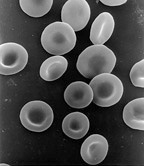
Photo from wikipedia
Iron deficiency anaemia (IDA) presents the treating clinician with two issues: first, the need to establish a cause, and second, the need to correct the anaemia to improve symptoms and… Click to show full abstract
Iron deficiency anaemia (IDA) presents the treating clinician with two issues: first, the need to establish a cause, and second, the need to correct the anaemia to improve symptoms and prevent complications. With a wide spectrum of severity, a host of potential causes ranging from benign to life-threatening, and multiple options for correction, one can expect significant variation in the management of IDA among clinicians. It is within this context that Brookes et al take a macroscopic view of the trends in incidence and management of IDA in England between 2012 and 2018.1 A number of pertinent observations have been made. Overall, secondary care encounters for IDA increased, presumably due to increased recognition; there was a 68% increase in total hospital encounters for a primary diagnosis of IDA, encompassing a 58% increase in non-elective and 74% increase in day-case hospital encounters. The relative increase in day-case in comparison to non-elective management is important, given the significantly greater costs associated with the latter; while total annual day-case management costs in 2017/2018 (£46 million) were similar to total non-elective costs (£42.4 million), four times as many patients were managed as day-cases (n=1 03 806) compared with non-electively (n=25 275). However, there was noticeably wide variation among different health networks across England in rates of non-elective management, signifying a need for a unified approach. Given the large cost discrepancy, an important question to answer is how best to manage patients in order to facilitate day-case management and prevent non-elective admissions. This should begin with ensuring early recognition of IDA. The association between deprivation and non-elective admissions suggests that lower socioeconomic status patients may be more likely to present at a later, more severe stage requiring admission. The …
Journal Title: Frontline Gastroenterology
Year Published: 2020
Link to full text (if available)
Share on Social Media: Sign Up to like & get
recommendations!